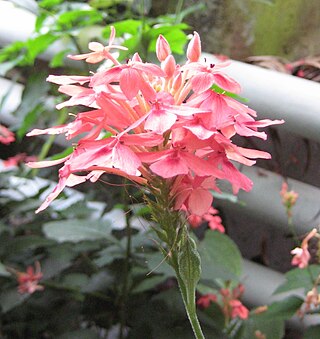
Meliaceae, the mahogany family, is a flowering plant family of mostly trees and shrubs in the order Sapindales.

Hydrochorea is a genus of flowering plants in the family Fabaceae. It includes 11 species native to Central and South America and west and west-central Africa. It belongs to the mimosoid clade of the subfamily Caesalpinioideae.

Turraea is a genus of plants in the family Meliaceae, native to the Old World tropics and subtropics.
Preussiodora is a genus of plants in the family Rubiaceae. It contains only one species, Preussiodora sulphurea, native to central Africa.

The genus Barteria is in the family Passifloraceae in the major group angiosperms. It contains 8 described species, however, only 6 are accepted.

Afroguatteria is a small genus of flowering plants in the family Annonaceae, native to Cabinda and Zaire in west Africa. They are climbers, and are closely related to Toussaintia.

Stapfiella is a genus of flowering plants belonging to the family Passifloraceae. It is also in the Subfamily Turneroideae.

Reissantia is a genus of flowering plants belonging to the family Celastraceae.

Girardinia is a genus of flowering plants belonging to the family Urticaceae.
Guyonia is a genus of flowering plants belonging to the family Melastomataceae.
Lankesteria is a genus of flowering plants belonging to the family Acanthaceae.

Lindackeria is a genus of flowering plants belonging to the family Achariaceae.
Donella is a genus of flowering plants belonging to the family Sapotaceae.

Stayneria is a genus of flowering plants belonging to the family Aizoaceae. It contains a single species, Stayneria neilii. It is in the subfamily Ruschioideae and the tribe Ruschieae.

Ritchiea is a genus of flowering plants belonging to the family Capparaceae.
Gambeya is a genus of flowering plants belonging to the family Sapotaceae.
Heckeldora is a genus of flowering plants belonging to the family Meliaceae. They are shrubs or small trees with odd-pinnate leaves. Plants are dioecious, with male and female flowers on separate plants.
Maclaudia is a monotypic genus of flowering plants belonging to the family Apocynaceae. It only contains one known species, Maclaudia felixii Venter & R.L.Verh.

Ruspolia is a genus of flowering plants belonging to the family Acanthaceae.

Neoguarea glomerulata is a species of flowering plant in the family Meliaceae. It is a tree or shrub native to west-central tropical Africa, ranging from southern Nigeria through Cameroon, Equatorial Guinea, Gabon, Republic of the Congo, and Democratic Republic of the Congo. It is the sole species in genus Neoguarea. It grows in lowland Guineo-Congolian rainforest.











